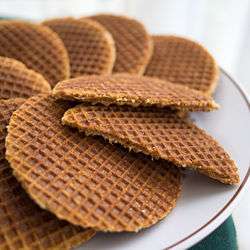Waffle
A waffle is a dish made from leavened batter or dough that is cooked between two plates that are patterned to give a characteristic size, shape, and surface impression. There are many variations based on the type of waffle iron and recipe used. Waffles are eaten throughout the world, particularly in Belgium, which has over a dozen regional varieties.[1] Waffles may be made fresh or simply heated after having been commercially cooked and frozen.
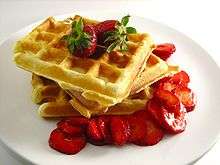 Waffles with strawberry topping | |
| Alternative names | Stack of waffles topped with sliced strawberries |
|---|---|
| Place of origin | France, Belgium |
| Main ingredients | Batter or dough |
| Variations | Liège waffle, Brussels Waffle, Flemish Waffle, Bergische waffle, Stroopwafel and others |
Etymology
The word "waffle" first appears in the English language in 1725: "Waffles. Take flower, cream..."[2] It is directly derived from the Dutch wafel, which itself derives from the Middle Dutch wafele.[3]
While the Middle Dutch wafele is first attested to at the end of the 13th century, it is preceded by the French walfre in 1185; both from Frankish wafla 'honeycomb' or 'cake'.[4][5]
Alternate spellings throughout modern and medieval Europe include waffe, wafre, wafer, wâfel, waufre, iauffe, gaufre, goffre, gauffre, wafe, waffel, wåfe, wāfel, wafe, vaffel, and våffla.[6][7]
History
Medieval origins
In ancient times the Greeks cooked flat cakes, called obelios, between hot metal plates. As they were spread throughout medieval Europe, the cake mix, a mixture of flour, water or milk, and often eggs, became known as wafers and were also cooked over an open fire between iron plates with long handles.[8]

Waffles are preceded, in the early Middle Ages, around the period of the 9th–10th centuries, with the simultaneous emergence of fer à hosties / hostieijzers (communion wafer irons) and moule à oublies (wafer irons).[9][10] While the communion wafer irons typically depicted imagery of Jesus and his crucifixion, the moule à oublies featured more trivial Biblical scenes or simple, emblematic designs.[9] The format of the iron itself was almost always round and considerably larger than those used for communion.[11][12]
The oublie was, in its basic form, composed only of grain flour and water – just as was the communion wafer.[13] It took until the 11th century, as a product of The Crusades bringing new culinary ingredients to Western Europe, for flavorings such as orange blossom water to be added to the oublies; however, locally sourced honey and other flavorings may have already been in use before that time.[13][14]
Oublies, not formally named as such until ca. 1200, spread throughout northwestern continental Europe, eventually leading to the formation of the oublieurs guild in 1270.[15][16] These oublieurs/obloyers were responsible for not only producing the oublies but also for a number of other contemporaneous and subsequent pâtisseries légères (light pastries), including the waffles that were soon to arise.[16]
14th–16th centuries
In the late 14th century, the first known waffle recipe was penned in an anonymous manuscript, Le Ménagier de Paris, written by a husband as a set of instructions to his young wife.[17] While it technically contains four recipes, all are a variation of the first: Beat some eggs in a bowl, season with salt and add wine. Toss in some flour, and mix. Then fill, little by little, two irons at a time with as much of the paste as a slice of cheese is large. Then close the iron and cook both sides. If the dough does not detach easily from the iron, coat it first with a piece of cloth that has been soaked in oil or grease.[18] The other three variations explain how cheese is to be placed in between two layers of batter, grated and mixed in to the batter, or left out, along with the eggs.[19] However, this was a waffle / gaufre in name only, as the recipe contained no leavening.
Though some have speculated that waffle irons first appeared in the 13th–14th centuries, it was not until the 15th century that a true physical distinction between the oublie and the waffle began to evolve.[9] Notably, while a recipe like the fourth in Le Ménagier de Paris was only flour, salt and wine – indistinguishable from common oublie recipes of the time – what did emerge was a new shape to many of the irons being produced. Not only were the newly fashioned ones rectangular, taking the form of the fer à hosties, but some circular oublie irons were cut down to create rectangles.[9] It was also in this period that the waffle's classic grid motif appeared clearly in a French fer à oublie and a Belgian wafelijzer – albeit in a more shallowly engraved fashion – setting the stage for the more deeply gridded irons that were about to become commonplace throughout Belgium.[20][21]
By the 16th century, paintings by Joachim de Beuckelaer, Pieter Aertsen and Pieter Bruegel clearly depict the modern waffle form.[22] Bruegel's work, in particular, not only shows waffles being cooked, but fine detail of individual waffles. In those instances, the waffle pattern can be counted as a large 12x7 grid, with cleanly squared sides, suggesting the use of a fairly thin batter, akin to contemporary Brussels waffles (Brusselse wafels).[23]
The earliest of the 16th century waffle recipes, Om ghode waffellen te backen – from the Dutch KANTL 15 manuscript (ca. 1500–1560) – is only the second known waffle recipe after the four variants described in Le Ménagier de Paris.[24] For the first time, partial measurements were given, sugar was used, and spices were added directly to the batter: Take grated white bread. Take with that the yolk of an egg and a spoonful of pot sugar or powdered sugar. Take with that half water and half wine, and ginger and cinnamon.[25]
Alternately attributed to the 16th and 17th centuries, Groote Wafelen from the Belgian Een Antwerps kookboek was published as the first recipe to use leavening (beer yeast): Take white flour, warm cream, fresh melted butter, yeast, and mix together until the flour is no longer visible. Then add ten or twelve egg yolks. Those who do not want them to be too expensive may also add the egg white and just milk. Put the resulting dough at the fireplace for four hours to let it rise better before baking it.[26] Until this time, no recipes contained leavening and could therefore be easily cooked in the thin moule à oublies. Groote Wafelen, in its use of leavening, was the genesis of contemporary waffles and validates the use of deeper irons (wafelijzers) depicted in the Beuckelaer and Bruegel paintings of the time.[23]

By the mid-16th century, there were signs of waffles' mounting French popularity. Francois I, king from 1494–1547, of whom it was said les aimait beacoup (loved them a lot), had a set of waffle irons cast in pure silver.[27][28] His successor, Charles IX enacted the first waffle legislation in 1560, in response to a series of quarrels and fights that had been breaking out between the oublieurs. They were required "d'être au moins à la distance de deux toises l'un de l'autre." (to be no less than 4 yards from one to the other).[16]
17th–18th centuries
Moving into the 17th century, unsweetened or honey-sweetened waffles and oublies – often made of non-wheat grains – were the type generally accessible to the average citizen.[16][29] The wheat-based and particularly the sugar-sweetened varieties, while present throughout Europe, were prohibitively expensive for all but the monarchy and bourgeoisie.[16] Even for the Dutch, who controlled much of the mid-century sugar trade, a kilogram of sugar was worth ½ an ounce of silver (the equivalent of ~$7 for a 5 lb. bag, 01/2016 spot silver prices), while, elsewhere in Europe, it fetched twice the price of opium.[30][31] The wealthier families' waffles, known often as mestiers, were, "...smaller, thinner and above all more delicate, being composed of egg yolks, sugar, and the finest of the finest flour, mixed in white wine. One serves them at the table like dessert pastry."[16]
By the dawn of the 18th century, expansion of Caribbean plantations had cut sugar prices in half.[30] Waffle recipes abounded and were becoming decadent in their use of sugar and other rare ingredients.[32] For instance, Menon's gaufre from Nouveau Traité de la Cuisine included a livre of sugar for a demi-livre of flour.[33]
Germany became a leader in the development and publication of waffle recipes during the 18th century, introducing coffee waffles, the specific use of Hefeweizen beer yeast, cardamom, nutmeg, and a number of zuickerwaffeln (sugar waffles).[34][35] At the same time, the French introduced whipped egg whites to waffles, along with lemon zests, Spanish wine, and cloves.[36] Joseph Gillier even published the first chocolate waffle recipe, featuring three ounces of chocolate grated and mixed into the batter, before cooking.[37]
A number of the 18th century waffle recipes took on names to designate their country or region/city of origin – Schwedische Waffeln, Gauffres à l'Allemande and, most famous of all the 18th century varieties, Gauffres à la Flamande, which were first recorded in 1740.[37][38] These Gauffres à la Flamande (Flemish waffles / Gaufres de Lille) were the first French recipe to use beer yeast, but unlike the Dutch and German yeasted recipes that preceded them, use only egg whites and over a pound of butter in each batch.[38] They are also the oldest named recipe that survives in popular use to the present day, produced regionally and commercially by Meert.[39]
The 18th century is also when the word "waffle" first appeared in the English language, in a 1725 printing of Court Cookery by Robert Smith.[40] Recipes had begun to spread throughout England and America, though essentially all were patterned after established Dutch, Belgian, German, and French versions.[41] Waffle parties, known as 'wafel frolics', were documented as early as 1744 in New Jersey, and the Dutch had earlier established waffles in New Amsterdam (New York City).[42][43]

Liège waffles, the most popular contemporary Belgian waffle variety, are rumored to have been invented during the 18th century, as well, by the chef to the prince-bishop of Liège.[44][45] However, there are no German, French, Dutch, or Belgian cookbooks that contain references to them in this period – by any name – nor are there any waffle recipes that mention the Liège waffle's distinctive ingredients, brioche-based dough and pearl sugar.[46] It is not until 1814 that Antoine Beauvilliers publishes a recipe in l'Art du Cuisiner where brioche dough is introduced as the base of the waffle and sucre cassé (crushed block sugar) is used as a garnish for the waffles, though not worked into the dough.[47] Antonin Carême, the famous Parisian pastry chef, is the first to incorporate gros sucre into several waffle variations named in his 1822 work, Le Maitre d'Hotel Français.[48] Then, in 1834, Leblanc publishes a complete recipe for gaufres grêlées (hail waffles), where gros sucre is mixed in.[49] A full Gaufre de Liège recipe does not appear until 1921.[50]
19th–21st centuries
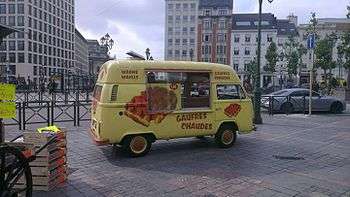
Waffles remained widely popular in Europe for the first half of the 19th century, despite the 1806 British Atlantic naval blockade that greatly inflated the price of sugar.[51] This coincided with the commercial production of beet sugar in continental Europe, which, in a matter of decades, had brought the price down to historical lows.[52] Within the transitional period from cane to beet sugar, Florian Dacher formalized a recipe for the Brussels Waffle, the predecessor to American "Belgian" waffles, recording the recipe in 1842/43.[53][54][55] Stroopwafels (Dutch syrup wafels), too, rose to prominence in the Netherlands by the middle of the century.[53] However, by the second half of the 1800s, inexpensive beet sugar became widely available, and a wide range of pastries, candies and chocolates were now accessible to the middle class, as never before; waffles' popularity declined rapidly.[51][52]
By the early 20th century, waffle recipes became rare in recipe books, and only 29 professional waffle craftsmen, the oublieurs, remained in Paris.[53][56] Waffles were shifting from a predominantly street-vendor-based product to an increasingly homemade product, aided by the 1918 introduction of GE's first electric commercial waffle maker.[57] By the mid-1930s, dry pancake/waffle mix had been marketed by a number of companies, including Aunt Jemima, Bisquick, and a team of three brothers from San Jose, Calif. – the Dorsas. It is the Dorsas who would go on to innovate commercial production of frozen waffles, which they began selling under the name "Eggo" in 1953.[58] Manufacturers are now testing the production of waffles with potato starch, which increase the stability of the waffle and protect them from sticking to the iron.[59]
Belgian-style waffles were showcased at Expo 58 in Brussels.[60] Another Belgian introduced Belgian-style waffles to the United States at the 1962 Seattle World's Fair, but only really took hold at the 1964 New York World's Fair, when another Belgian entrepreneur introduced his "Bel-Gem" waffles.[61] In practice, contemporary American "Belgian waffles" are actually a hybrid of pre-existing American waffle types and ingredients and some attributes of the Belgian model.
Even as most of the original recipes have faded from use, a number of the 18th and 19th century varieties can still be easily found throughout Northern Europe, where they were first developed.
Varieties
 Brussels waffle
Brussels waffle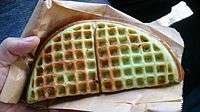 Plain waffle sold at a neighborhood store in Singapore.
Plain waffle sold at a neighborhood store in Singapore..jpg) Rolled waffles
Rolled waffles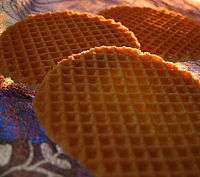 Waffle cookies made in Belgium and imported to the United States.
Waffle cookies made in Belgium and imported to the United States.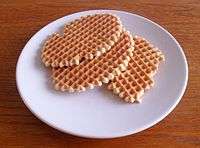 Galettes campinoises
Galettes campinoises
- Brussels waffles[62] are prepared with an egg-white-leavened or yeast-leavened batter, traditionally an ale yeast;[63] occasionally both types of leavening are used together. They are lighter, crisper and have larger pockets compared to other European waffle varieties, and are easy to differentiate from Liège Waffles by their rectangular sides. In Belgium, most waffles are served warm by street vendors and dusted with confectioner's sugar, though in tourist areas they might be topped with whipped cream, soft fruit or chocolate spread. Variants of the Brussels waffles – with whipped and folded egg whites cooked in large rectangular forms – date from the 18th century.[64] However, the oldest recognized reference to "Gaufres de Bruxelles" (Brussels Waffles) by name is attributed from 1842/43 to Florian Dacher, a Swiss baker in Ghent, Belgium, who had previously worked under pastry chefs in central Brussels.[65] Philippe Cauderlier would later publish Dacher's recipe in the 1874 edition of his recipe book "La Pâtisserie et la Confiture". Maximilien Consael, another Ghent chef, had claimed to have invented the waffles in 1839, though there's no written record of him either naming or selling the waffles until his participation in the 1856 Brussels Fair.[66][67] Neither man created the recipe; they simply popularized and formalized an existing recipe as the Brussels waffle.[68]
- The Liège waffle[69] is a richer, denser, sweeter, and chewier waffle. Native to the greater Wallonia region of Eastern Belgium – and alternately known as gaufres de chasse (hunting waffles) – they are an adaptation of brioche bread dough, featuring chunks of pearl sugar which caramelize on the outside of the waffle when baked. It is the most common type of waffle available in Belgium and prepared in plain, vanilla and cinnamon varieties by street vendors across the nation.
- Flemish waffles, or Gaufres à la Flamande, are a specialty of northern France and portions of western Belgium.[70] The original recipe, published in 1740 by Louis-Auguste de Bourbon in Le Cuisinier Gascon, is as follows: Take "deux litrons" (1.7 liters or 7 cups) of flour and mix it in a bowl with salt and one ounce of brewer's yeast barm. Moisten it completely with warm milk. Then whisk fifteen egg whites and add that to the mixture, stirring continuously. Incorporate "un livre" (490 grams or 1.1 pounds) of fresh butter, and let the batter rise. Once the batter has risen, take your heated iron, made expressly for these waffles, and wrap some butter in a cloth and rub both sides of the iron with it. When the iron is completely heated, make your waffles, but do so gently for fear of burning them. Cooked, take them out, put them on a platter, and serve them with both sugar and orange blossom water on top.[71]
- American waffles[72] vary significantly. Generally denser and thinner than the Belgian waffle, they are often made from a batter leavened with baking powder, which is sometimes mixed with pecans, chocolate drops or berries and may be round, square, or rectangular in shape. Like American pancakes they are usually served as a sweet breakfast food, topped with butter and maple syrup, bacon, and other fruit syrups, honey, or powdered sugar. They are also found in many different savory dishes, such as fried chicken and waffles or topped with kidney stew.[73] They may also be served as desserts, topped with ice cream and various other toppings. A large chain (over 2,100 locations) of waffle specialty diners, Waffle House, is ubiquitous in the southern United States.

- Belgian waffles are a North American waffle variety, based on a simplified version of the Brussels waffle.[74] Recipes are typically baking soda leavened, though some are yeast-raised.[75] They are distinguished from standard American waffles by their use of 1 ½" depth irons.[76] Belgian waffles take their name from an oronym of the Bel-Gem brand, which was an authentic Brussels waffle vendor that helped popularize the thicker style at the 1964 New York World's Fair.[77]
- Bergische waffles, or Waffles from Berg county,[78] are a specialty of the German region of Bergisches Land. The waffles are crisp and less dense than Belgian waffles, always heart shaped, and served with cherries, cream and optionally rice pudding as part of the traditional afternoon feast on Sundays in the region.
- Hong Kong style waffle, in Hong Kong called a "grid cake" or "grid biscuits" (格仔餅), is a waffle usually made and sold by street hawkers and eaten warm on the street.[79] It is similar to a traditional waffle but larger, round in shape and divided into four quarters. It is usually served as a snack. Butter, peanut butter and sugar are spread on one side of the cooked waffle, and then it is folded into a semicircle to eat. Eggs, sugar and evaporated milk are used in the waffle recipes, giving them a sweet flavor. They are generally soft and not dense. Traditional Hong Kong style waffles are full of the flavor of yolk. Sometimes different flavors, such as chocolate and honey melon, are used in the recipe and create various colors. Another style of Hong Kong waffle is the eggette or gai daan jai (鷄蛋仔), which have a ball-shaped pattern.
- Pandan waffles originate from Vietnam and are characterized by the use of pandan flavoring and coconut milk in the batter.[80] The pandan flavoring results in the batter's distinctive spring green color.[81] When cooked, the waffle browns and crisps on the outside and stays green and chewy on the inside. Unlike most waffles, pandan waffles are typically eaten plain. In Vietnam they are relatively cheap and so are popular among children.[82] They are a popular street food made in either cast iron molds heated with charcoal or in electric waffle irons.[83]

- Kue gapit is an Indonesian kue kering (dry snack) which originates from West Java. Generally made from tapioca flour, its name comes from the cooking process, in which it is grilled between iron molds like a waffle. The snack comes in a variety of shapes and flavors.
- Scandinavian style waffles, common throughout the Nordic countries, are thin, made in a heart-shaped waffle iron. The batter is similar to other varieties. The most common style are sweet, with whipped or sour cream and strawberry or raspberry jam, or berries, or simply sugar, on top.
- In Norway, brunost and gomme are also popular toppings. As with crèpes, there are those who prefer a salted style with various mixes, such as blue cheese.
- In Finland, savory toppings are uncommon; instead jam, sugar, whipped cream or vanilla ice cream are usually used.
- In Iceland, the traditional topping is either rhubarb or blueberry jam with whipped cream on top. Syrup and chocolate spread are also popular substitutes for the jam.
- The Swedish tradition dates at least to the 15th century, and there is even a particular day for the purpose, Våffeldagen (waffle day), which sounds like Vårfrudagen ("Our Lady's Day"), and is therefore used for the purpose. This is March 25 (nine months before Christmas), the Christian holiday of Annunciation.[84] They are usually topped with strawberry jam, bilberry jam, cloudberry jam, raspberry jam, bilberry and raspberry jam, sugar and butter, vanilla ice cream and whipped cream. Other, savory, toppings include salmon roe, cold-smoked salmon and cream fraiche.
- Gofri (singular gofre) are waffles in Italy and can be found in the Piedmontese cuisine: they are light and crispy in texture, contain no egg or milk (according to the most ancient recipe)[85] and come both in sweet and savory versions.[86] Central Italian cuisine also features waffle-like cookies, which are locally known as pizzelle, ferratelle (in Abruzzo) or cancelle (in Molise).
- Stroopwafels are thin waffles with a syrup filling, which originated from the Dutch city of Gouda. The stiff batter for the waffles is made from flour, butter, brown sugar, yeast, milk, and eggs. Medium-sized balls of batter are put on the waffle iron. When the waffle is baked and while it is still warm, it is cut into two halves. The warm filling, made from syrup is spread in between the waffle halves, which glues them together.[87] They are popular in the Netherlands and Belgium and sold in pre-prepared packages in shops and markets.
- Galettes campinoises/Kempense galetten are a type of waffle popular in Belgium. They are rigid and crunchy, but are buttery, crumbly and soft in the mouth.
- Hotdog waffles are long waffles with a hot dog cooked inside them, similar to a corn dog. Originating in Thailand, this snack is served with ketchup, mayonnaise, or both. The batter is similar to American waffles, but uses margarine instead of butter, as it is one of the more accepted eccentricities of their food culture.[88]
- Waffles on a stick are long waffles cooked onto a stick, usually dipped in something like chocolate syrup, and with sprinkles on top.[89]
Toppings
Waffles can be eaten plain (especially the thinner kinds) or eaten with various toppings, such as:
- butter
- chocolate chips
- apple butter
- dulce de leche
- fruits:
- honey
- jam or jelly
- chocolate spread
- peanut butter
- syrup:
- whipped cream
- powdered sugar
Ice cream cones are also a type of waffles or wafers.
Waffles are also eaten with savory rather than sweet toppings.[90][91][92][93]
Consistency
On the industrial scale, waffles are baked at 140–180 °C for 110 and 180 s, depending on thickness and batter type. Waffles should be fully baked and golden brown but not burnt. To decrease product loss, whether in the kitchen or in a factory, a waffle needs to be stable (not torn during take off). The ideal waffle should also have an even color throughout and not be crumbly. The perfect waffle is made of finely granulated wheat flour with low to medium protein content and low water adsorption capacity. The recommended pH value for waffle batter is from 6.1-6.5. High pH values can cause an increase in the browning reaction which causes an increase in the amount of batter residues on the waffle iron and therefore, more sticking.[94]
Waffle batter temperature should be in the range of 21 to 26.6 degrees Celsius.[94] If batter temperature is too high the batter forms clumps and sticks to the apparatus. Density and viscosity are also important aspects that have an effect on overall waffle quality. The recommended density of a waffle should be about 80–95 g/100 ml because it needs to be fluid enough to fill the whole plate of the waffle iron. Too stiff, and the dough’s spreadability decreases. Too much liquid, and the batter runs right off the plate. Viscosity is influenced by density (higher the density the higher the viscosity) but in the case of waffles, the effect of CO2 gas is more prevalent. The more aeration, the stiffer the waffle gets and the more viscous it is (it becomes foam-like). Aeration is the major factor that determines viscosity in a recipe so overall, the higher the aeration, the lower the density, and the higher the viscosity. Recipes vary for different types of waffles. Usually, better air-filled batters contribute to softer, fluffier waffles but viscosity should remain lower in order to have sufficient spreadability. Softer waffles do not have a correlation with sticking behavior. Density and viscosity do not have effect on sticking or adhering properties.[94]
Shelf stability and staling
Mixing is a critical step in batter preparation since overmixing causes the gluten to develop excessively and create a batter with too high of a viscosity that is difficult to pour and does not expand easily. A thick batter that is difficult spreading in the baking iron has an increased water activity of around 0.85. The increased viscosity made it harder for water to evaporate from the waffle causing an increase in water activity. The control waffles with a softer texture had a water activity of 0.74 after cooking. The Aw is less because the softer texture allows the water to evaporate. With an increased storage time, waffle physical and textural properties changes regardless of the batter viscosity.[95] Aged waffles shrink because air bubbles leak out and the structure starts to condense. Hardness and viscosity also increases as time goes by. Aged waffle samples displayed a starch retrogradation peak that increased with storage time due to the fact that more crystalline structures were present. Starch retrogradation is mentioned previously in this paper. The enthalpy value for melting of starch crystals increased with storage time as well.[95]
See also
- Eggo
- Krumkake
- List of quick breads
- Moffle – a waffle prepared using mochi
- Pancake
- Pizzelle
- Potato waffle mainly found in the UK and Ireland, made from potato formed into a waffle iron shape
- Egg waffle
References
- "Les Gaufres Belges" Archived 2012-08-20 at the Wayback Machine. Gaufresbelges.com. Retrieved on 2013-04-07.
- Robert Smith (1725). Court Cookery. p. 176.
- "Waffle" Archived 2013-04-07 at the Wayback Machine, The Merriam-Webster Unabridged Dictionary
- "Gaufre" Archived 2012-05-01 at the Wayback Machine, Centre National de Ressources Textuelles et Lexicales
- Larousse Gastronomique. Crown Publishing Group. 2001. p. 1285. ISBN 978-0-609-60971-2.
- fr:Gaufre (cuisine)
- "Bulletin de la Société liégeoise de littérature wallonne, Volumes 34-35". 1894. Retrieved June 6, 2015.
- https://www.thekitchn.com/from-wafers-to-cones-a-short-h-113627
- "Les Moules à Oublies" Archived 2013-06-02 at the Wayback Machine, Gilles Soubigou, Conservateur du Patrimoine, Monuments Historiques – Lorraine
- "De historie van wafels en wafelijzers" Archived 2014-01-01 at the Wayback Machine, Nederlands Bakkerijmuseum
- "fer à hosties" Archived 2013-06-02 at the Wayback Machine, 13e siècle, Conservation des antiquités et objets d'art de Charente-Maritime – Ministère de la Culture (France), PM17000403
- "fer à oublies ", Gourmet Museum and Library, Hermalle-sous-Huy, Belgium
- Gil Marks (2010). Encyclopedia of Jewish Food. Wiley. p. 431. ISBN 978-0-470-94354-0.
- Jean Liebault, La maison rustique, 1582, cité dans Raymond Lecoq, Les Objets de la vie domestique. Ustensiles en fer de la cuisine et du foyer des origines au XIX siècle, Berger-Levrault, 1979, p. 180.
- "Oublie" Archived 2011-02-19 at the Wayback Machine, Centre National de Ressources Textuelles et Lexicales
- Adolphe Chéruel (1865). Dictionnaire historique des institutions: mœurs et coutumes de la France. L. Hachette et cie. p. 243.
- "LE MENAGIER DE PARIS" Archived 2013-07-12 at the Wayback Machine, Michael Delahoyde, Washington State University
- "Gauffres iiii manières", circa 1392–1394, anonymous author, Paris, B.N.F. fr. 12477, fol. 171 r
- "Gauffres iiii manières " Archived 2012-08-05 at the Wayback Machine, translation by Janet Hinson, David D. Friedman
- "Wafelijzer, Brugge, 1430", Gruuthusemuseum / Royal Institute for Cultural Heritage
- "Gaufrier de Girard le Pâtissier", Un Fer à Gaufres du Quinzieme siècle, H. Henry, Besançon, France
- "Gemüseverkäuferin", Pieter Aertsen, 1567, Stiftung preussischer Kulturbesitz – Staatliche Museen, Berlin
- "Het gevecht tussen Carnaval en Vasten", Pieter Bruegel (the elder), 1569
- " Gent KANTL 15, volume 1" Archived 2012-09-03 at the Wayback Machine, Christianne Muusers (translator), Coquinaria
- "Om ghode waffellen te backen" Archived 2012-05-10 at the Wayback Machine, Christianne Muusers (translator), Coquinaria
- André Delcart (2007). "Groote Wafelen". Winterfeesten en gebak. Maklu. p. 38. ISBN 978-90-8575-009-3.
- Adolphe Chéruel (1865). Dictionnaire historique des institutions, moeurs et coutumes de la France, 1. Libr. de L. Hachette. p. 477.
- Les Français peints par eux-mêmes: encyclopédie morale du 19e siècle. Curmer. 1841. p. 220.
- Maurice Laporte (1571). Les épithètes. p. 112.
- "The Price of Sugar in the Atlantic, 1550–1787" Archived 2012-08-15 at the Wayback Machine, Figure I, Klas Rönnbäck, Europ. Rev. Econ. Hist., 2009
- "Recipes | In Season" Archived 2012-07-20 at the Wayback Machine, July: Rhubarb, Gourmet Magazine, Gourmet Traveller, Adelaide Lucas
- Johann Nikolaus Martius (1719). Unterricht von der wunderbaren Magie und derselben medicinischen Gebrauch. Nicolai. p. 164.
- Menon (1739). Nouveau traité de la Cuisine, Volume 1. p. 334.
- Johanna Katharina Morgenstern-Schulze (1785). Unterricht für ein junges Frauenzimmer, das Küche und Haushaltung selbst besorgen will, Volume 1. p. 310.
- Stettinisches Kochbuch für junge Frauen, Haushälterinnen und Köchinnen: Nebst einem Anhange von Haus- und Wirtschaftsregeln. Keffke. 1797. p. 371.
- "Gaufres" Archived 2015-10-17 at the Wayback Machine, Les Dons de Comus, T. 3, p. 131, 1758
- "Gauffre" Archived 2015-10-17 at the Wayback Machine, Le Cannameliste français, p. 111, 1751.
- Beatrice Fink (1995). Les Liaisons savoureuses: réflexions et pratiques culinaires au XVIIIe siècle. Université de Saint-Etienne. p. 159. ISBN 978-2-86272-070-8.
- "Meert, Depuis 1761" Archived 2011-08-19 at Wikiwix. Meert.fr. Retrieved on 2013-04-07.
- Robert Smith (cook.) (1725). Court cookery: or, The compleat English cook. p. 1.
- Robert Smith (cook.) (1725). Court cookery: or, The compleat English cook. p. 176. Retrieved 7 April 2013.
- John Austin Stevens; Benjamin Franklin DeCosta; Henry Phelps Johnston, Volume 2, Issue 2; Martha Joanna Lamb; Nathan Gilbert Pond (1878). The Magazine of American history with notes and queries. A. S. Barnes. p. 442.CS1 maint: multiple names: authors list (link)
- M.J. Stephey (23 November 2009) "Waffles" Archived 2012-08-23 at the Wayback Machine, TIME Magazine.
- Bart Biesemans (16 July 2011) "Luikse wafel verdringt Brusselse wafel", De Standaard.
- "Waffles" Archived 2013-10-29 at the Wayback Machine, visitBelgium.com
- "The history of the "Gaufre de Liège"" Archived 2012-08-30 at the Wayback Machine, gofre.eu
- Antoine B. Beauvilliers (1814). L'art du cuisinier ... Pilet.
- Marie Antonin Carême (1822). Le Maitre d'hotell français: ou parallèle de la cuisine ancienne et moderne ... Didot. p. 33.
- Leblanc (pastry cook.) (1834). Manuel du pâtissier: ou, Traité complet et simplifié de la pâtisserie de ménage, de boutique et d'hôtel ... Librairie encyclopédique de Roret. p. 200.
- André Delcart (2007). Winterfeesten en gebak. Maklu. p. 49. ISBN 978-90-8575-009-3.
- "From extreme luxury to everyday commodity" Archived 2014-04-08 at the Wayback Machine, Sugar in Sweden, 17th to 20th centuries, pp. 8–9, Klas Rönnbäck, Göteborg Papers in Economic History, No. 11. November 2007
- "Sweet Diversity: Overseas Trade and Gains from Variety after 1492" Archived 2013-07-26 at the Wayback Machine, Jonathan Hersh, Hans-Joachim Voth, Real Sugar Prices and Sugar Consumption Per Capita in England, 1600–1850, p.42
- "Wafels" Archived 2012-08-06 at the Wayback Machine, Henk Werk,
- "Jaargang 25 inclusief het boek "Brusselse Wafels"" Archived 2014-04-08 at the Wayback Machine, Academie voor de Streekgebonden Gastronomie
- "Brusselse Wafels" Archived 2012-08-17 at Wikiwix, Philippe Cauderlier, 1874
- "OUBLIEUR" Archived 2013-12-18 at the Wayback Machine, Les métiers d'autrefois, genealogie.com
- William George (2003). Antique Electric Waffle Irons 1900–1960: A History of the Appliance Industry in 20th Century America. Trafford Publishing. p. 74. ISBN 978-1-55395-632-7.
- Sherri Liberman (2011). American Food by the Decades. ABC-CLIO. p. 134. ISBN 978-0-313-37698-6.
- Huber, Regina; Schoenlechner, Regine (May 2017). "Waffle production: influence of batter ingredients on sticking of fresh egg waffles at baking plates-Part I: effect of starch and sugar components". Food Science & Nutrition. 5 (3): 504–512. doi:10.1002/fsn3.424. PMC 5448360. PMID 28572935.
- "Marollenwijk smult van Brusselse wafels", Leen Dewitte, De Standaard, standard.be, maandag 03 maart 2008
- "Bel-Gem Waffles" Archived 2012-07-20 at the Wayback Machine, Bill Cotter
- "Brussels Waffle Recipe" Archived 2016-02-07 at the Wayback Machine, Adam Wayda, 2016-01-15
- "Een nieuwe, royale oud-Belgische hoofdstedelijke wafel?" Archived 2012-03-01 at the Wayback Machine, faro | tijdschrift over cultureel erfgoed, Belgium (in Dutch), pp 14–21, 03/03/2008
- "le de brusselier", "Petite histoire de la cuisine"
- "Om te backen, dicke wafelen" Archived 2013-04-07 at the Wayback Machine. deswaene.be. Retrieved on 2013-04-07.
- Henk Werk (22 February 2012). Wafels Archived 2012-08-06 at the Wayback Machine. Home.hccnet.nl. Retrieved on 2013-04-07.
- Lonely Planet Encounter Guide Brussels, Bruges, Antwerp & Ghent 1st edition, 2008, p. 151
- waffle-recipes.com (1 June 2015). Brusselse Wafels: Dacher's and Consael's Recipes "Brusselse Wafels: Dacher's and Consael's Recipes". 2015-06-02. Archived from the original on 2015-06-02. Retrieved 2015-06-02..
- "Liège Waffle Recipe / Gaufres de Liège". 2014-03-10. Archived from the original on 2014-03-14. Retrieved 2014-03-14. ["Liège Waffle Recipe"], Adam Wayda, 2014-03-13
- M. Bounie (2003/2004) La Gaufre Flamande Fourrée Archived 2013-03-21 at the Wayback Machine, Polytech'Lille-Département IAA, p 6.
- Beatrice Fink (1995). Les Liaisons savoureuses: réflexions et pratiques culinaires au XVIIIe siècle. Université de Saint-Etienne. p. 159. ISBN 978-2-86272-070-8.
- "American waffle recipe". Lonestar.texas.net. Archived from the original on 2012-04-25. Retrieved 2012-05-02.
- Davidson, Alan (1999). The Oxford Companion to Food. Oxford: Oxford University press. pp. xx + 892. ISBN 978-0192806819.
- "His waffles made memories at the Queens World's Fair". Newsday. 1989-08-22.
- http://www.foodnetwork.com/search/search-results.html?searchTerm=belgian+waffle&form=global&_charset_=UTF-8 ["Belgian Waffle Recipes"], Food Network
- "Archived copy". Archived from the original on 2015-05-13. Retrieved 2015-03-22.CS1 maint: archived copy as title (link) ["Nemco Belgian Waffle Irons"], Nemco
- Roberts, Sam (2008-07-27). "A Fair, a Law and the Urban Walker". The New York Times. Archived from the original on November 13, 2013. Retrieved 2009-03-19.
- "Bergish Waffle recipe" (in German). Remscheid, Germany: Bergisches-wiki.de. Archived from the original on 2012-04-26. Retrieved 2012-05-02.
- "Descriptions of Hong Kong Waffles". Mrnaomi.wordpress.com. 2008-01-23. Archived from the original on 2012-04-22. Retrieved 2012-05-02.
- Katharine Shilcutt (July 2, 2011). "100 Favorite Dishes: No. 81, Pandan Waffles at Parisian Bakery III". Archived from the original on November 7, 2011. Retrieved November 5, 2011.
- "Pandan Waffles Banh Kep La Dua". January 15, 2011. Archived from the original on November 3, 2011. Retrieved November 5, 2011.
- Hong & Kim (15 January 2011). "Pandan Waffles Banh Kep La Dua". Archived from the original on 3 November 2011. Retrieved 5 November 2011.
- "Vietnamese Coconut Waffles Recipe". 30 August 2007. Archived from the original on 3 November 2011.
- "Waffles Day - Våffeldagen". visitsweden.com. Retrieved 2020-07-30.
- "I gofri" (in Italian). Turin, Italy: Gofreria Piemonteisa - Torino. Archived from the original on 2015-12-22. Retrieved 2015-12-13.
- "I GOFRI". cucinapiemontese.blogspot.it. Archived from the original on 30 June 2017. Retrieved 4 May 2018.
- Stroopwafels. Traditional delicacys. Retrieved on 2008-01-02
- "Archived copy". Archived from the original on 2016-11-10. Retrieved 2016-11-10.CS1 maint: archived copy as title (link)
- "LollyWaffle". lollywaffle.com. Archived from the original on 28 August 2017. Retrieved 4 May 2018.
- "7 Savory Waffles You Can Eat for Dinner".
- "Savory Waffles Six Ways".
- "Savory Waffles".
- "25 Mostly Savory Gourmet Waffles". 2016-07-16.
- Huber, Regina; Schoenlechner, Regine (2016-09-01). "Waffle production: influence of batter ingredients on sticking of fresh egg waffles at baking plates—Part I: effect of starch and sugar components". Food Science & Nutrition: n/a–n/a. doi:10.1002/fsn3.424. ISSN 2048-7177.
- Sozer, Nesli; Kokini, Jozeph (2009). COMBAT RATION NETWORK FOR TECHNOLOGY IMPLEMENTATION. THE CENTER FOR ADVANCED FOOD TECHNOLOGY: DEFENSE LOGISTICS AGENCY.
External links


- Waffle recipes in the Cookbook wikibook
